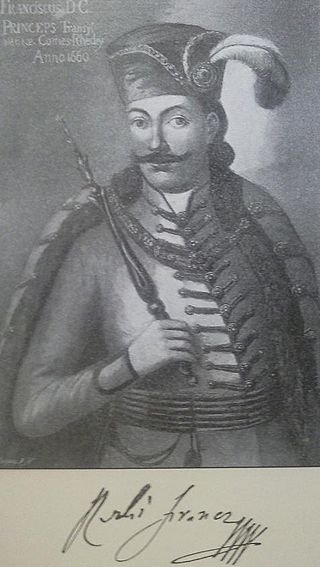In Hungarian history, and especially in the history of Transylvania, there are few families as prominent as the Rhédeys. They came from an impoverished noble family from the Hungarian Highlands in the northern part of the Kingdom of Hungary, their ancestors being descended from the Aba clan. Later, however, they gave Transylvania a prince and even became related to the English royal family.

Count Rhédey Ferenc of Kisréde was the Prince of Transylvania between 1657 and 1658. His father was Rhédey Ferenc, Chief Captain of Várad, Chief Comes of Bihar County and his mother was Károlyi Kata. As a rule, the Chief Captain of Várad Castle wielded the second-greatest military power in the Principality of Transylvania.

This little-known Transylvanian prince was born in Várad (Oradea) around 1610. His wife was Bethlen Druzsina, niece of Prince Bethlen Gábor, daughter of Bethlen István (Prince Gábor’s younger brother), who reigned briefly in 1630. The royal kinship was a great boost to Rhédey’s career. In the summer of 1648, the old prince Rákóczi György gave him the post of Chief Comes of Máramaros, but he was also a confidant of the younger prince Rákóczi György, as he remained a princely councilor.
When Prince Rákóczi György II marched his army against Poland, Rhédey was elected to the 3-member governor’s council, more exactly from January 1657 he held the post of governor of Transylvania together with Barcsai Ákos and Serédi István. In the unfortunate campaign of Prince Rákóczi II György in Poland, he was one of the commanders of the Transylvanian army.

On 2 November 1657, Rákóczi, who had been punished by the Sublime Porte, was deposed and Rhédey was elected Prince of Transylvania in his place. However, Rákóczi and Rhédey agreed that the latter would only hold the title of prince temporarily.

Two months later, on 9 January, the Transylvanian Estates again declared their support for Rákóczi. The fact that Rákóczi organized an army in the Partium region from the soldiers of the Borderland castles, the nobility, and the local population, that he recruited the Hajdú troops and the Székelys, and that the key castle of Várad also sided with him, probably contributed to the decision to regain the throne. On the other hand, Rhédey had no soldiers.

Rhédey resigned and left Transylvania for a short time. Transylvanian historian Szalárdi János wrote the following about the event:
“When the Transylvanian people elected Rhédei Ferenc as their prince, the great (Ottoman) Emperor was pleased with him and allowed him to be sent a letter of Athnames and a banner. But the Transylvanians, without the emperor’s knowledge, deposed him from the principality; was this not a great fault and a great crime on the part of the Transylvanians?”.
He was right, for if Rhédey had remained in the principality, the Turkish armies would not have been able to unleash themselves on Transylvania. However, while Rákóczi managed to gather a considerable army and the garrison of Várad stood by him,

His contemporaries appreciated his religious devotion. It was well known that Rhédey, like the old Rákóczi György, had read the Bible several times, prayed regularly and read every day. His greatest deed was considered to be that he had fulfilled his duty to the respublica and the ecclesia, knowing that he had to accept his office for the sake of peace.

After the death of Rákóczi in 1660, the election of his son László (or possibly his nephew Zólyomi Dávid) as prince was again discussed at the Sublime Porte, but in the end, Apaffy Mihály became ruler. The Emperor and King Leopold I granted Rhédey the title of Count. Rhédey remained in the Council of Princes alongside Apaffy. He did much to support the Reformed Church. He died in the castle of Huszt.

Sources: Szibler Gábor and Hungarian Wikipedia
Dear Readers, I can only make this content available through small donations or by selling my books or T-shirts. Please, support me with a coffee here:
You can check out my books on Amazon or Draft2Digital, they are available in hardcover, paperback, or ebook:
or at https://books2read.com/b/boYd81

My work can also be followed and supported on Patreon: http://Become a Patron!




